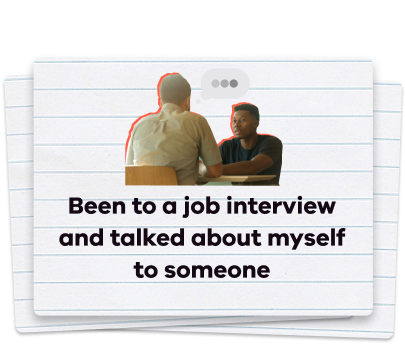A lot of what interviewers need to know about your qualifications and suitability for a role is covered in your resume. In an interview situation, the first few questions are ‘warm-up- questions and tend to stick to these topics.
They will ask you a wider selection of questions to see what type of person you are and whether you’re a good fit for the job and the company.
If you have an idea about what those questions might be you can practise your answers before the interview.
Here are some different types of interview questions you might be asked. And suggestions for ways to answer them.
Common interview questions
Job interviews often follow a common pattern. Many of the same questions come up again and again.
These tend to be:
1. Tell me about yourself
This question is often asked at the start of an interview. The interviewer wants to know about your skills and experience. They're interested in things that show you could do the job well.
Here's how you could answer:
- If you've had other jobs before, talk about what they were and what you did.
- If you’ve never had a paid job, you can also describe other experience you have, like playing in a sporting team, or volunteering with a community group.
- Try to relate your experience to the job you're being interviewed for.
For example, if you're going for a job that involves working with other people you could say, ‘Playing soccer has taught me how to work well with others in a team environment to achieve a common goal. We won the premiership last year. It made me realise that if people work together as a team, they can achieve something big.’
2. Why did you apply for this job?
When an interviewer asks this question, they're not asking about why you're looking for work. They want to know you've thought about what you can bring to the job.
Answering this question is a good opportunity to show you've done some research into the business and know why you want to work there.
Here's how you could answer:
- Start out by saying, ‘Because I think I can really help you to…’
- Then talk about what you think the job involves.
- Next, tell them how your experience matches the skills needed for the job.
- Never say, ‘Because I need the money.’ – even though this is the main reason we apply for a job
For example, if you're going for a job in a warehouse you could say, ‘I've done this kind of job before and I found it really fun. I have good attention to detail. I know how to carefully check deliveries against the inventory for any mistakes.’
3. Tell me about a problem you had and how you solved it
When interviewers ask this question, they want to know how you deal with problems and that you can cope with challenges.
Here's how you could answer:
- Choose a tough situation you've faced in the past.
- You can use examples from things that have happened in your job, family, school, community or sporting club.
- Relate your story back to the job you're going for.
- Show that the skills you used to solve the problem are relevant to the job.
- Finish with the outcome, what was the result of you solving the problem
For example, if you're going for a job in retail you could say, ‘I volunteered at a community event and dealt with a difficult person who claimed they were overcharged. I stayed calm, listened to what they said, and tried to solve their problem. When I couldn't, I got the event manager to help.’
4. What are your strengths?
Interviewers often ask you to talk about your strengths. This means the things you're good at. This is a good chance to sell yourself as the right person for the job. In this instance, talking yourself up is a good thing.
Here's how you could answer:
- Choose one or two things you're good at.
- Explain how these things will help you do the job well.
- Use examples from your experience. Show that you can put your strengths into action.
- Don't lie or exaggerate.
For example, maybe you're persistent. You could explain, ‘When I start something, I have to see it all the way through to the end. When I worked as a kitchen hand, I stayed until the kitchen was clean at the end of my shift.’
5. What are your weaknesses?
After asking you about your strengths, interviewers often ask about your weaknesses. This means the things you're not so good at.
It can be hard to talk about things you aren't good at. This is a chance to show that you know what you need to improve about yourself.
Here's how you could answer:
- Choose one specific thing you can improve on.
- Make sure you pick something that's not essential to the job.
- Talk about what you're doing to improve.
For example, maybe you're not good at public speaking. You could explain, ‘Every time I have to speak in a team meeting, I get nervous and I have trouble getting my words out. It's something I'm working on by practising at home.’
Tricky interview questions
Tricky questions are all part of the interview process so preparing your answers can help take the pressure off.
For example, interviewers might ask an awkward question if there are gaps in your resume or work history. They might want to find out the reasons why you left your last job, or why you haven’t had a job for a while.
Don’t spend too much time answering awkward questions. It’s best to deal with them as quickly and as positively as you can.
Here’s a list of our top three awkward job interview questions you might get, and some ways you can answer them. We also have advice about how to tackle inappropriate questions.
1. Why did you leave your last job?
Here are some reasons you could give for leaving your last job:
- I’d learned as much as I could there, and I needed a change.
- I had to travel too far to get to work.
- There weren’t any opportunities to progress.
- The shifts my boss wanted me to work clashed with my study.
- I’ve gained more qualifications now, and I’m looking for the next step in my career.
2. Why have you had so many jobs?
You don’t want the interviewer to think you can’t commit to a job. Here are some possible answers to this tricky interview question.
- I wanted to try different jobs to broaden my skills. All the different experience I’ve got gives me lots of things that I can bring to this job.
- I wasn’t sure where I wanted to work. Now I’m clear about what I want to do, so I’m ready to devote myself to one workplace.
3. Why were you out of work for so long?
You don’t want the interviewer to think that no one wants to employ you. It's better to say you chose to take time off between jobs. This might be because you:
- needed a break for physical or emotional reasons
- wanted to do further study
- were travelling to gain experience
- needed to care for a parent or family member.
4. Have you ever had a disagreement with your boss?
You’re probably tempted to think of disagreements as a bad thing. But disagreements are a normal part of life. What the interviewer really wants to know is how you deal with conflict.
You could talk about:
- what you did to resolve the situation
- how you used your communication skills
- the positive outcomes of any conflict for you and the wider team
Preparing for group interviews
Sometimes you might be invited to a group interview. This is when an employer interviews a group of potential employees all at the same time.
Group interviews are often used as a timesaver for large organisation. They are also used to see how you interact with others, how you communicate and how you cope under pressure.
This can mean that questions asked in a group situation might be quite different to those in a traditional one-on-one interview.
For example, you might be asked things like:
- How would you weigh a bus without using scales?
- You have a three-litre jug and a five-litre jug. How do you measure one litre of water?
The thing to remember with questions like this is that there is no right answer, an employer is looking at how you communicate your thinking and how you work with others.

